
Understanding the Problem
Healthcare waste poses a significant risk to human health and the environment. While most healthcare waste is considered general, a concerning 15% is classified as hazardous. This includes items like infectious waste, sharps, chemical waste, and pharmaceutical waste. Improper handling can lead to infections, injuries, and environmental contamination.
What is Hazardous Healthcare Waste?
Hazardous healthcare waste is any waste generated in healthcare settings that poses a risk to human health or the environment. This includes:
- Infectious waste: Contaminated with blood or other bodily fluids.
- Sharps: Needles, syringes, and other sharp objects.
- Pathological waste: Human tissue or organs.
- Chemical waste: Disinfectants, cleaning agents, and other chemicals.
- Pharmaceutical waste: Expired or unused medications.
- Cytotoxic waste: Cancer treatment drugs.
- Radioactive waste: Materials containing radioactive substances.
Improper handling of hazardous healthcare waste can have severe consequences for both human health and the environment.
Here are some of the primary risks:
- Infection: Exposure to infectious waste can lead to the spread of diseases among healthcare workers, patients, and the general public.
- Injuries: Sharps like needles and syringes pose a significant risk of accidental punctures, which can lead to infections.
- Environmental contamination: Improper disposal of hazardous waste can contaminate soil, water, and air, leading to long-term environmental damage.
- Antibiotic resistance: The improper disposal of antibiotics can contribute to the development of drug-resistant bacteria.
- Toxic exposure: Chemicals and heavy metals found in healthcare waste can be harmful to human health and the environment if not managed properly.
Discover best practices for segregation, collection, storage, and disposal.
Segregate
- Properly sort waste into designated containers based on its type (e.g., sharps, infectious, chemical).
Contain
- Place waste in appropriate containers, ensuring they are securely closed and labeled correctly.
Treat
- Employ appropriate treatment methods such as incineration, autoclaving, or chemical disinfection based on waste type.
Dispose
- Follow local regulations and guidelines for final disposal, including landfill or recycling options.
Make sure to wear appropriate PPE during the disposal process to minimize exposure risks.
- Gloves: Disposable gloves are essential for preventing skin contact with hazardous materials. The type of glove (e.g., nitrile, latex) will depend on the specific hazards involved. Recommended: Frontier c3-35cm nitrile chemitouch glove
- Gowns: Disposable gowns provide a barrier between the wearer's clothing and potential contaminants. (Remommended: Frontier microporous coverall
- Masks or respirators: Depending on the type of waste, masks or respirators may be necessary to protect the respiratory system from airborne particles or chemicals. Recommended: Frontier p2 flat fold with valve respirator
- Eye protection: Safety goggles or face shields should be worn to protect the eyes from splashes or splatters. Recommended: Force360 guardian smoke lens goggle
- Boot covers: Disposable boot covers can help prevent the spread of contamination. Recommended: Force360 sms disposable boot cover
It's essential to work with licensed and qualified waste management companies to ensure compliance with all regulations and environmental protection standards.
By following these steps and adhering to strict guidelines, healthcare facilities can effectively manage hazardous waste, protecting both human health and the environment.













































